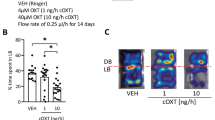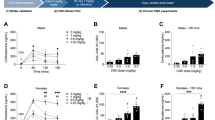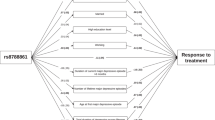Abstract
Astressin, a novel corticotropin releasing factor (CRF) antagonist, has been found to be particularly potent at inhibiting the hypothalamo-pituitary-adrenal axis. The aim of the present study was to determine the effects in rats of astressin in attenuating the anxiogenic-like response produced by social stress and intracerebroventricular (ICV) CRF administration on the elevated plus-maze, and ICV CRF-induced locomotor activation in the rat. Astressin significantly reversed the anxiogenic-like response induced by both social stress and ICV rat/humanCRF (r/hCRF) on the elevated plus-maze, but failed to block the effects of r/hCRF-induced locomotor activity in a familiar environment. When these results were compared to previous studies performed with the same paradigms using other CRF antagonists, astressin showed effects similar to those of D-PheCRF(12-41) on plus-maze performance. However, contrary to α-helicalCRF(9-41) and D-PheCRF(12-41), astressin had no effect on CRF-induced locomotor activity. These results suggest that astressin may have a unique anti-CRF profile compared to previously tested antagonists.
Similar content being viewed by others
Log in or create a free account to read this content
Gain free access to this article, as well as selected content from this journal and more on nature.com
or
References
Ando T, Rivier J, Yanaihara H, Arimura A . (1998): Peripheral corticotropin-releasing factor mediates the elevation of plasma IL-6 by immobilization stress in rats. Am J Physiol 275: R1461–R1467
Aubry JM, Turnbull AV, Pozzoli G, Rivier C, Vale W . (1997): Endotoxin decreases corticotropin-releasing factor receptor 1 messenger ribonucleic acid levels in the rat pituitary. Endocrinology 138: 1621–1626
Baldwin HA, Rassnick S, Rivier J, Koob GF, Britton KT . (1991): CRF antagonist reverses the “anxiogenic” response to ethanol withdrawal in the rat. Psychopharmacology 103: 227–232
Baram TZ, Koutsoukos Y, Schultz L, Rivier J . (1996): The effect of “Astressin,” a novel antagonist of corticotropin releasing hormone (CRH), on CRH-induced seizures in the infant rat: Comparison with two other antagonists. Mol Psychiat 1: 223–226
Behan DP, Heinrichs SC, Troncoso JC, Liu XJ, Kawas CH, Ling N, De Souza EB . (1995): Displacement of corticotropin releasing factor from its binding protein as a possible treatment for Alzheimer's disease. Nature 378: 284–287
Chalmers DT, Lovenberg TW, De Souza EB . (1995): Localization of novel corticotropin-releasing factor receptor (CRF2) mRNA expression to specific subcortical nuclei in rat brain: Comparison with CRF1 receptor mRNA expression. J Neurosci 15: 6340–6350
Chen R, Lewis KA, Perrin MH, Vale WW . (1993): Expression cloning of a human corticotropin-releasing-factor receptor. Proc Nat Acad Sci USA 90: 8967–8971
Curtis AL, Grigoriadis DE, Page ME, Rivier J, Valentino RJ . (1994): Pharmacological comparison of two corticotropin-releasing factor antagonists: in vivo and in vitro studies. J Pharmacol Exp Ther 268: 359–365
Dunn AJ, Berridge CW . (1990): Physiological and behavioral responses to corticotropin-releasing factor administration: is CRF a mediator of anxiety or stress responses? Brain Res Rev 15: 71–100
Gulyas J, Rivier C, Perrin M, Koerber SC, Sutton S, Corrigan A, Lahrichi SL, Craig AG, Vale W, Rivier J . (1995): Potent, structurally constrained agonists and competitive antagonists of corticotropin-releasing factor. Proc Nat Acad Sci USA 92: 10575–10579
Heinrichs SC, Merlo-Pich E, Miczek KA, Britton KT, Koob GF . (1992): Corticotropin-releasing factor antagonist reduces emotionality in socially defeated rats via direct neurotropic action. Brain Res 581: 190–197
Hernandez JF, Kornreich W, Rivier C, Miranda A, Yamamoto G, Andrews J, Tache Y, Vale W, Rivier J . (1993): Synthesis and relative potencies of new constrained CRF antagonists. J Med Chem 36: 2860–2867
Kirk RE . (1982): Experimental Design Procedures for the Behavioral Sciences, 2nd ed. Pacific Grove, CA, Brooks-Cole
Koob GF, Heinrichs SC, Merlo-Pich E, Menzaghi F, Baldwin H, Miczek K, Britton KT . (1993): The role of corticotropin-releasing factor in behavioral responses to stress. Ciba Found Symp 172: 277–289
Kostich WA, Chen A, Sperle K, Largent BL . (1998): Molecular identification and analysis of a novel human corticotropin-releasing factor (CRF) receptor: the CRF-28 receptor. Mol Endocrinol 12: 1077–1085
Lee S, Rivier C . (1997): Alcohol increases the expression of type 1, but not type 2 alpha corticotropin-releasing factor (CRF) receptor messenger ribonucleic acid in the rat hypothalamus. Mol Brain Res 52: 78–89
Lovenberg TW, Chalmers DT, Liu C, De Souza EB . (1995): CRF2α and CRF2β receptor mRNAs are differentially distributed between the rat central nervous system and peripheral tissues. Endocrinology 136: 4139–4142
Luthin DR, Youngblood KL, Rabinovich A, Brown MR, May JM . (1996): Corticotropin-releasing factor (CRF) mediates ACTH release and hypotension by two pharmacologically distinct CRF receptors subtypes. Soc Neurosci Abstr 22: 1545
Maecker H, Desai A, Dash R, Rivier J, Vale W, Sapolsky R . (1997): Astressin, a novel and potent CRF antagonist, is neuroprotective in the hippocampus when administered after a seizure. Brain Res 744: 166–170
Martinez V, Rivier J, Wang L, Tache Y . (1997): Central injection of a new corticotropin-releasing factor (CRF) antagonist, astressin, blocks CRF- and stress-related alterations of gastric and colonic motor function. J Pharmacol Exp Ther 280: 754–760
Martinez V, Barquist E, Rivier J, Tache Y . (1998): Central CRF inhibits gastric emptying of a nutrient solid meal in rats: The role of CRF2 receptors. Am J Physiol 274: G965–G970
Menzaghi F, Howard RL, Heinrichs SC, Vale W, Rivier J, Koob GF . (1994): Characterization of a novel and potent corticotropin-releasing factor antagonist in rats. J Pharmacol Exp Ther 269: 564–572
Merlo Pich E, Heinrichs SC, Rivier C, Miczek KA, Fisher DA, Koob GF . (1993): Blockade of pituitary-adrenal axis activation induced by peripheral immunoneutralization of corticotropin-releasing factor does not affect the behavioral response to social defeat stress in rats. Psychoneuroendocrinology 18: 495–507
Miczek KA . (1979): A new test for aggression in rats without aversive stimulation: Differential effects of d-amphetamine and cocaine. Psychopharmacology 60: 253–259
Miranda A, Lahrichi SL, Gulyas J, Koerber SC, Craig AG, Corrigan A, Rivier C, Vale W, Rivier J . (1997): Constrained corticotropin-releasing factor antagonist with i-(i+3)Glu-Lys bridges. J Med Chem 40: 3651–3658
Pellegrino LJ, Pellegrino AS, Cushman AJ . (1979): A Stereotaxic Atlas of the Rat Brain, 2nd ed. New York, Plenum Press
Perrin MH, Sutton S, Cervini LA, Rivier JE, Vale WW . (1999): Comparison of an agonist, urocortin, and an antagonist, astressin, as radioligands for characterization of corticotropin-releasing factor receptors. J Pharmacol Exp Ther 288: 729–734
Radulovic J, Rühmann A, Liepold T, Spiess J . (1999): Modulation of learning and anxiety by corticotropin-releasing factor (CRF) and stress: differential roles of CRF receptors 1 and 2. J Neurosci 19: 5016–5025
Rivier C, Rivier J, Lee S . (1996): Importance of pituitary and brain receptors for corticotropin-releasing factor in modulating alcohol-induced ACTH secretion in the rat. Brain Res 721: 83–90
Rivier J, Rivier C, Galyean R, Miranda A, Miller C, Craig AG, Yamamoto G, Brown M, Vale W . (1993): Single point D-substituted corticotropin-releasing factor analogs: Effects on potency and physicochemical characteristics. J Med Chem 36: 2851–2859
Rivier J, Rivier C, Vale W . (1984): Synthetic competitive antagonists of corticotropin-releasing factor: Effect on ACTH secretion in the rat. Science 224: 889–891
Rodriguez de Fonseca F, Rubio P, Menzaghi F, Merlo-Pich E, Rivier J, Koob GF, Navarro M . (1996): Corticotropin-releasing factor (CRF) antagonist [D-Phe12,Nle21,38,C alpha MeLeu37]CRF attenuates the acute actions of the highly potent cannabinoid receptor agonist HU-210 on defensive-withdrawal behavior in rats. J Pharmacol Exp Ther 276: 56–64
Takahashi LK, Kalin NH, Vanden Burgt JA, Sherman JE . (1989): Corticotropin-releasing factor modulates defensive-withdrawal and exploratory behavior in rats. Behav Neurosci 103: 648–654
Tazi A, Dantzer R, Le Moal M, Rivier J, Vale W, Koob GF . (1987): Corticotropin-releasing factor antagonist blocks stress-induced fighting in rats. Regul Pept 18: 37–42
Turnbull AV, Vaughan J, Rivier JE, Vale WW, Rivier C . (1999): Urocortin is not a significant regulator of intermittent electrofootshock-induced adrenocorticotropin secretion in the intact male rat. Endocrinology 140: 71–78
Vale W, Rivier C, Brown MR, Spiess J, Koob G, Swanson L, Bilezikjian L, Bloom F, Rivier J . (1983): Chemical and biological characterization of corticotropin releasing factor. Recent Prog Horm Res 39: 245–270
Vale W, Spiess J, Rivier C, Rivier J . (1981): Characterization of a 41-residue ovine hypothalamic peptide that stimulates secretion of corticotropin and β-endorphin. Science 213: 1394–1397
Wiersma A, Bohus B, Koolhaas JM . (1993): Corticotropin-releasing hormone microinfusion in the central amygdala diminishes a cardiac parasympathetic outflow under stress-free conditions. Brain Res 625: 219–227
Acknowledgements
The authors gratefully acknowledge Dr. Frederique Menzaghi for her great advice on the experimental procedures, Robert Lintz, Victoria Risborough, Ilham Polis, and Pete Griffin for their great help and excellent technical assistance, and Mike Arends for his thorough editing. This work was supported by NIH Grant DK 26741 from the National Institute of Diabetes and Digestive and Kidney Diseases. AMB was supported by Grant 1 F05 TW05262-02 from the Fogarty International Center, NIH. The experimental protocols for animals and their care were approved by the Institutional Review Committee for the use of Animal Subjects. This is publication number 11027-NP from The Scripps Research Institute.
Author information
Authors and Affiliations
Corresponding author
Rights and permissions
About this article
Cite this article
Spina, M., Basso, A., Zorrilla, E. et al. Behavioral Effects of Central Administration of The Novel CRF Antagonist Astressin in Rats. Neuropsychopharmacol 22, 230–239 (2000). https://doi.org/10.1016/S0893-133X(99)00108-6
Received:
Revised:
Accepted:
Issue date:
DOI: https://doi.org/10.1016/S0893-133X(99)00108-6
Keywords
This article is cited by
-
Differential blockade of CRF-evoked behaviors by depletion of norepinephrine and serotonin in rats
Psychopharmacology (2008)
-
Social Defeat Stress-Induced Behavioral Responses are Mediated by the Endogenous Kappa Opioid System
Neuropsychopharmacology (2006)
-
The effects of CRF antagonists, antalarmin, CP154,526, LWH234, and R121919, in the forced swim test and on swim-induced increases in adrenocorticotropin in rats
Psychopharmacology (2005)



